Project settings
Page summary:
Settings area spans project-level controls (general, billing, plans, invoices) and per-environment configuration.
From a chosen project's dashboard, the Settings button, located in the header, enables you to manage the configurations and settings for your Strapi Cloud project and its environments.
The settings' menu on the left side of the interface is separated into 2 categories: the settings for the entire project and the settings specific to any configured environment for the project.
Project-level settings
There are 5 tabs available for the project settings:
- General,
- Environments,
- Billing & Usage,
- Plans,
- and Invoices.
General
The General tab for the project-level settings enables you to check and update the following options for the project:
-
Basic information, to see:
- the name of your Strapi Cloud project — used to identify the project on the Cloud Dashboard, Strapi CLI, and deployment URLs — and change it (see Renaming project).
- the chosen hosting region for your Strapi Cloud project, meaning the geographical location of the servers where the project and its data and resources are stored. The hosting region is set at project creation (see Project creation) and cannot be modified afterwards.
- the project's metadata, including the Production app internal name and the Subscription ID, which can be useful for debugging & support purposes.
-
Strapi CMS license key: to enable and use some CMS features directly on your Cloud project (see Pricing page to purchase a license).
-
Connected Git repository: to change the repository and branch used for your project (see Modifying git repository & branch). Also allows to enable/disable the "deploy on push" option.
-
Danger zone, with:
- Transfer ownership: for the project owner to transfer the ownership of the Cloud project to an already existing maintainer (see Transferring project ownership).
- Delete project: to permanently delete your Strapi Cloud project (see Deleting Strapi Cloud project).

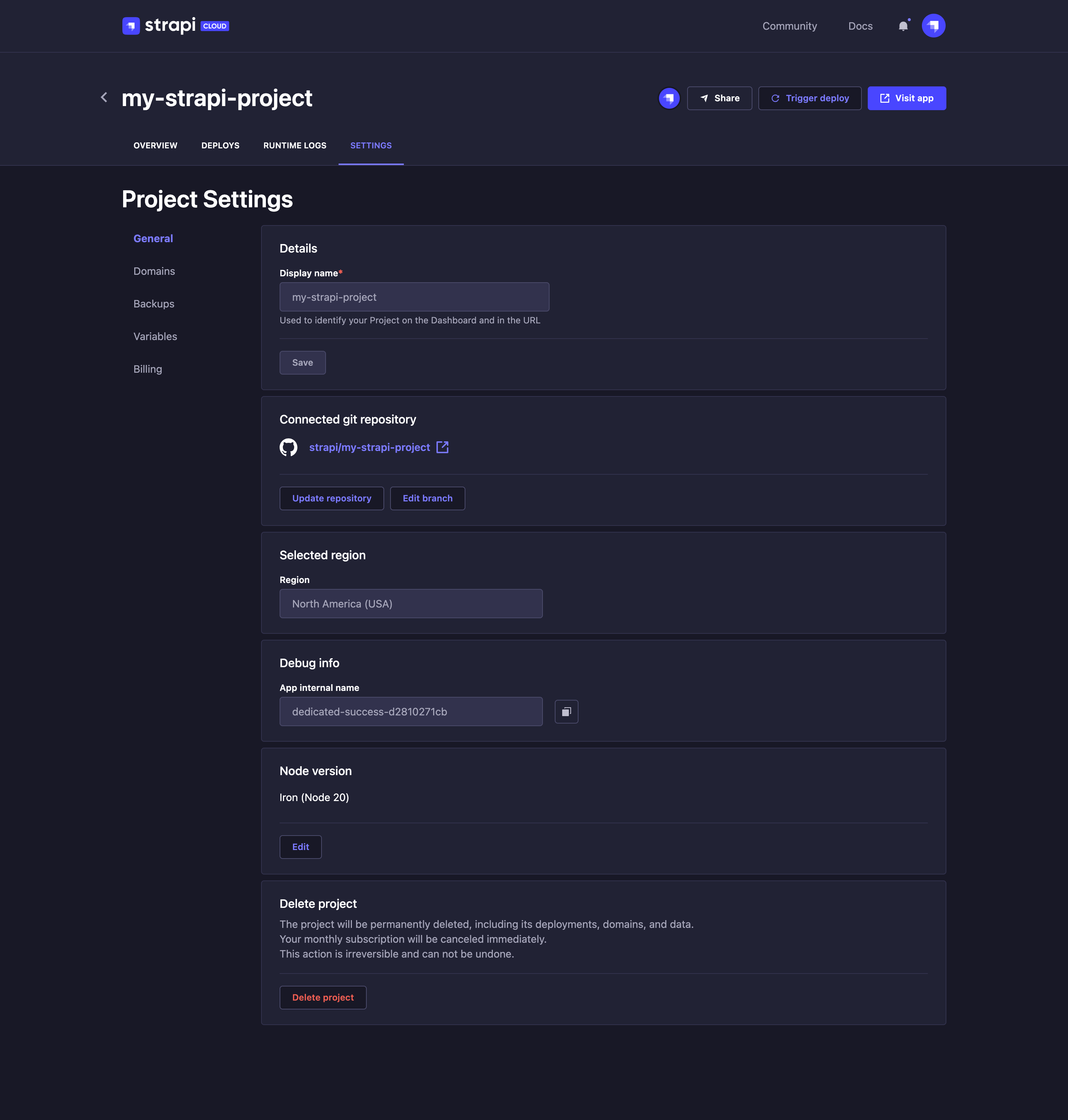
Renaming project
The project name is set at project creation (see Project creation) and can be modified afterwards via the project settings.
- In the Basic information section of the General tab, click on the edit button.
- In the dialog, write the new project name of your choice in the Project name textbox.
- Click on the Rename button to confirm the project name modification.
Adding a CMS license key
A CMS license key can be added and connected to a Strapi Cloud project to unlock additional Strapi CMS features across all of the project’s environments. The CMS features that will be accessible via the license key depend on the type of license that was purchased: please refer to the Strapi Pricing page for more information and/or to purchase a license.
If you don't see the Strapi CMS license key section, it probably means that your subscription is a legacy one and does not support custom CMS licenses. It means that you already have one that is automatically included on your project.
- In the Strapi CMS license key section, click on the Add license button.
- In the dialog, paste your license key in the field.
- Click on the Save & deploy button for the changes to take effect.
To remove the Strapi CMS license from your Strapi Cloud project, you can click on the Unlink license button. This will also remove access and usage to the CMS features included in the previously added license.
The license key is applied to all the environments in the project.
Modifying git repository & branch
The GitHub or GitLab repository, branch and base directory for a Strapi Cloud project are by default chosen at the creation of the project (see Creating a project). After the project's creation, via the project settings, it is possible to update the project repository or switch to another git provider.
Updating the git repository could result in the loss of the project and its data, for instance if the wrong repository is selected or if the data schema between the old and new repository doesn't match.
-
In the Connected git repository section of the General tab, click on the Update repository button. You will be redirected to another interface.
-
(optional) If you wish to not only update the repository but switch to another git provider, click on the Switch Git provider button at the top right corner of the interface. You will be redirected to the chosen git provider's authorization settings before getting back to the Update repository interface.
-
In the Update repository section, fill in the 2 available settings:
Setting name Instructions Account Choose an account from the drop-down list. Repository Choose a repository from the drop-down list. -
In the Select Git branches section, fill in the available settings for any of your environments. Note that the branch can be edited per environment via its own settings, see General (environment).
Setting name Instructions Branch Choose a branch from the drop-down list. Base directory Write the path of the base directory in the textbox. Auto-deploy Tick the box to automatically trigger a new deployment whenever a new commit is pushed to the selected branch. Untick it to disable the option. -
Click on the Save & deploy button for the changes to take effect.
Transferring project ownership Beta
The ownership of the Strapi Cloud project can be transferred to another user, as long as they're a maintainer of the project. It can either be at the initiative of the current project owner, or can be requested by a project maintainer. Once the ownership is transferred, it is permanent until the new owner decides to transfer the ownership again to another maintainer.
For the ownership of a project to be transferred, the following requirements must be met:
- The project must be on a paid plan, with no currently expired card and/or unpaid bills.
- The maintainer must have filled their billing information.
- No already existing ownership transfer must be pending for the project.
Note that ownership transfers might fail when done the same day of subscription renewal (i.e. 1st of every month). If the transfer fails that day, but all prerequisites are met, you should wait a few hours and try again.
- In the Danger zone section of the General tab, click on the Transfer ownership button.
- In the dialog:
- If you are the project owner: choose the maintainer who should be transferred the ownership by clicking on ... > Transfer ownership associated with their name.
- If you are a maintainer: find yourself in the list and click on ... > Transfer ownership associated with your name.
- Confirm the transfer/request in the new dialog by clicking on the Transfer ownership button.
An email will be sent to both users. The person who needs to transfer the ownership or inherit it will have to click on the Confirm transfer button in the email. Once done, the previous owner will receive a confirmation email that the transfer has successfully been done.
As long as the ownership transfer or request hasn't been confirmed, there is the option to cancel in the same dialog that the maintainer was chosen.
Once the ownership transfer is done, the project will be disconnected from Strapi Cloud. As new owner, make sure to go to the General tab of project settings to reconnect the project.
Deleting a Strapi Cloud project
You can delete any Strapi Cloud project, but it will be permanent and irreversible. Associated domains, deployments and data will be deleted as well and the subscription for the project will automatically be canceled.
- In the Danger zone section of the General tab, click on the Delete project button.
- In the dialog, select the reason why you are deleting your project. If selecting "Other" or "Missing feature", a textbox will appear to let you write additional information.
- Confirm the deletion of your project by clicking on the Delete project button at the bottom of the dialog.
Environments
ProThis feature is available with a Strapi Cloud Pro plan. ScaleThis feature is available with a Strapi Cloud Scale plan.The Environments tab allows to see all configured environments for the Strapi Cloud project, as well as to create new ones. Production is the default environment, which cannot be deleted. Other environments can be created (depending on the subscription plan for your project) to work more safely on isolated instances of your Strapi Cloud project (e.g. a staging environment where tests can be made before being available on production).

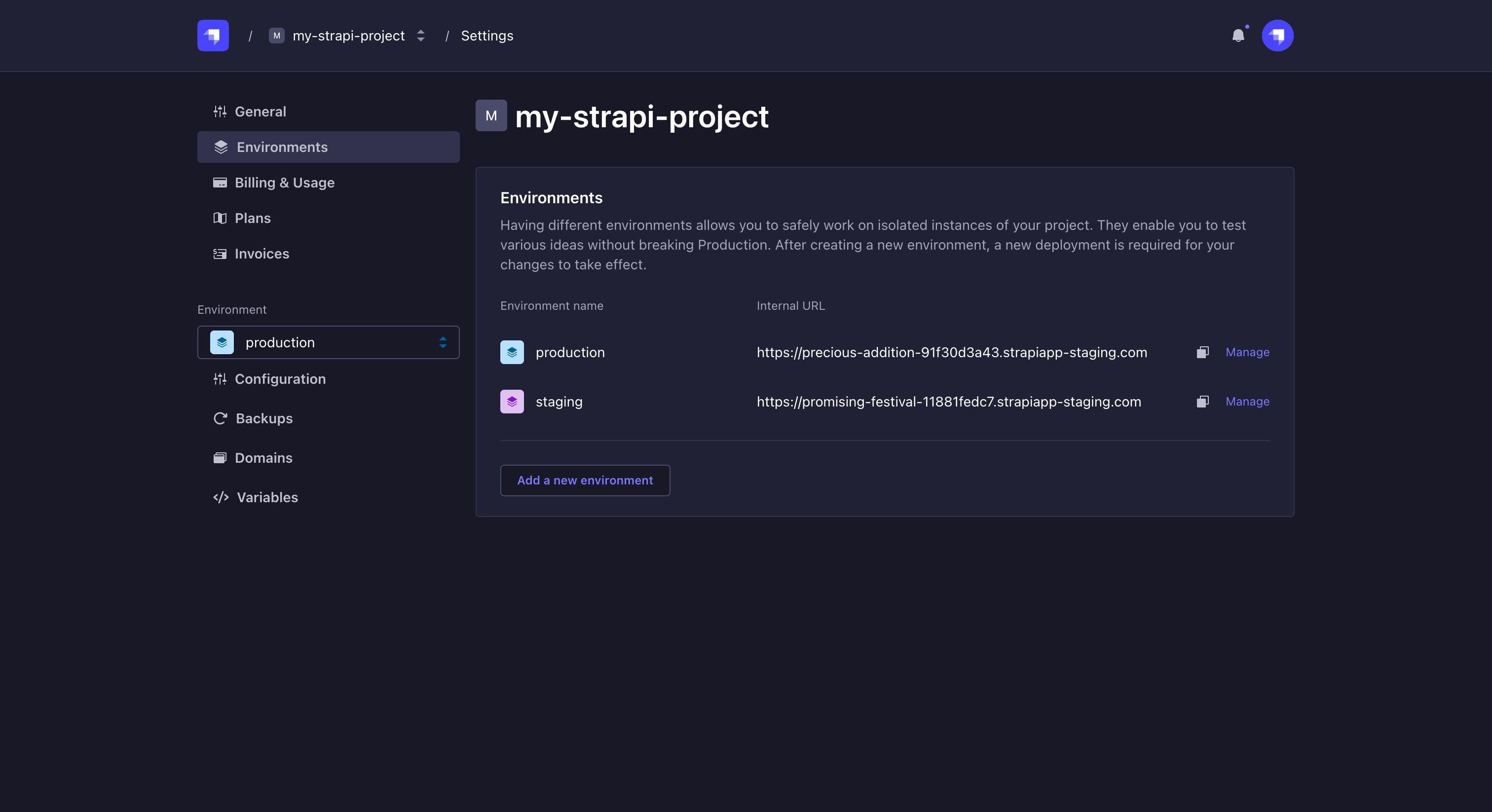
The billing cycle of additional environments you purchase will match the billing cycle of your plan.
To create a new environment:
-
Click on the Add a new environment button.
-
In the dialog that opens, you can see the price for the new environment and the date of the next invoice.
-
Fill in the available settings:
Setting name Instructions Environment name (mandatory) Write a name for your project's new environment. Git branch (mandatory) Select the right branch for your new environment. Base directory Write the name of the base directory of your new environment. Import variables Tick the box to import variable names from an existing environment. Values will not be imported, and all variables will remain blank. Deploy on push Tick this box to automatically trigger a deployment when changes are pushed to your selected branch. When disabled, you will need to manually deploy the latest changes. -
Click on the Add environment button to create your project's new environment. You will then be redirected to your Project dashboard where you will be able to follow your new environment's creation and first deployment.
If an error occurs during the environment creation, the progress indicator will stop and display an error message. You will see a Retry button next to the failed step, allowing you to restart the creation process.
Billing & Usage
The Billing & Usage tab displays your next estimated payment, all information on the current subscription plan and a detailed summary of the project's usage. It also allows you to add new environments (please refer to the documentation in the Environments section) for your project.
Through this tab, you also have the possibility to:
- click the Change button to be redirected to the Plans tab, where you can change you subscription plan or billing cycle (see related documentation),
- click the Edit button in order to set a new payment method (see related documentation).
You can attach a dedicated card to your project by choosing the payment method directly from this page. In that way, you can manage your subscriptions with different cards.
In the Usage section of the Billing & Usage tab, you can see the current monthly usage of your project compared to the maximum usage allowed by your project's subscription. Use the arrows in the top right corner to see the project's usage for any chosen month.
Note also that if your usage indicates that another subscription plan would fit better for your project, a message will be displayed in the Billing & Usage tab to advise which plan you could switch to.
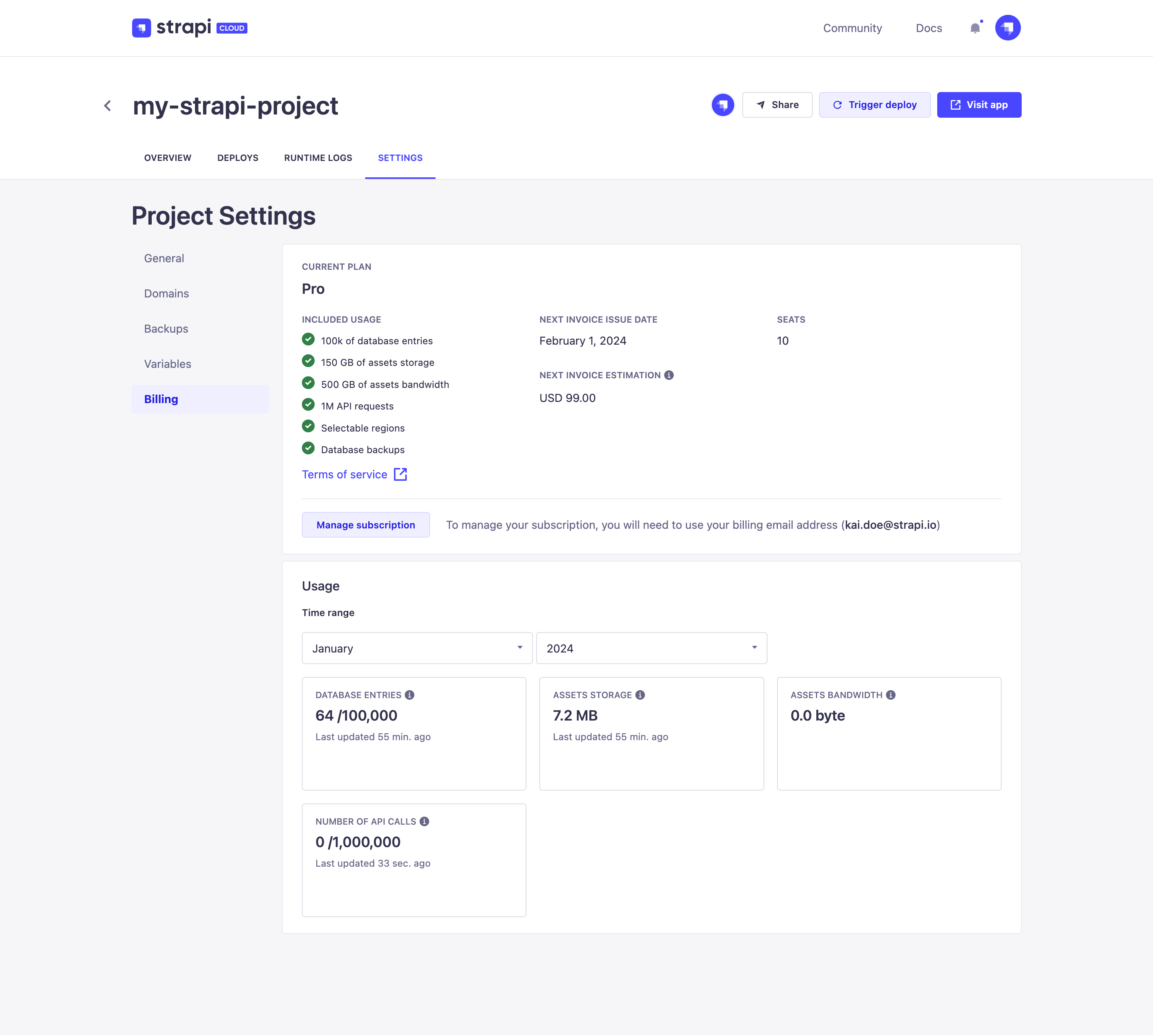
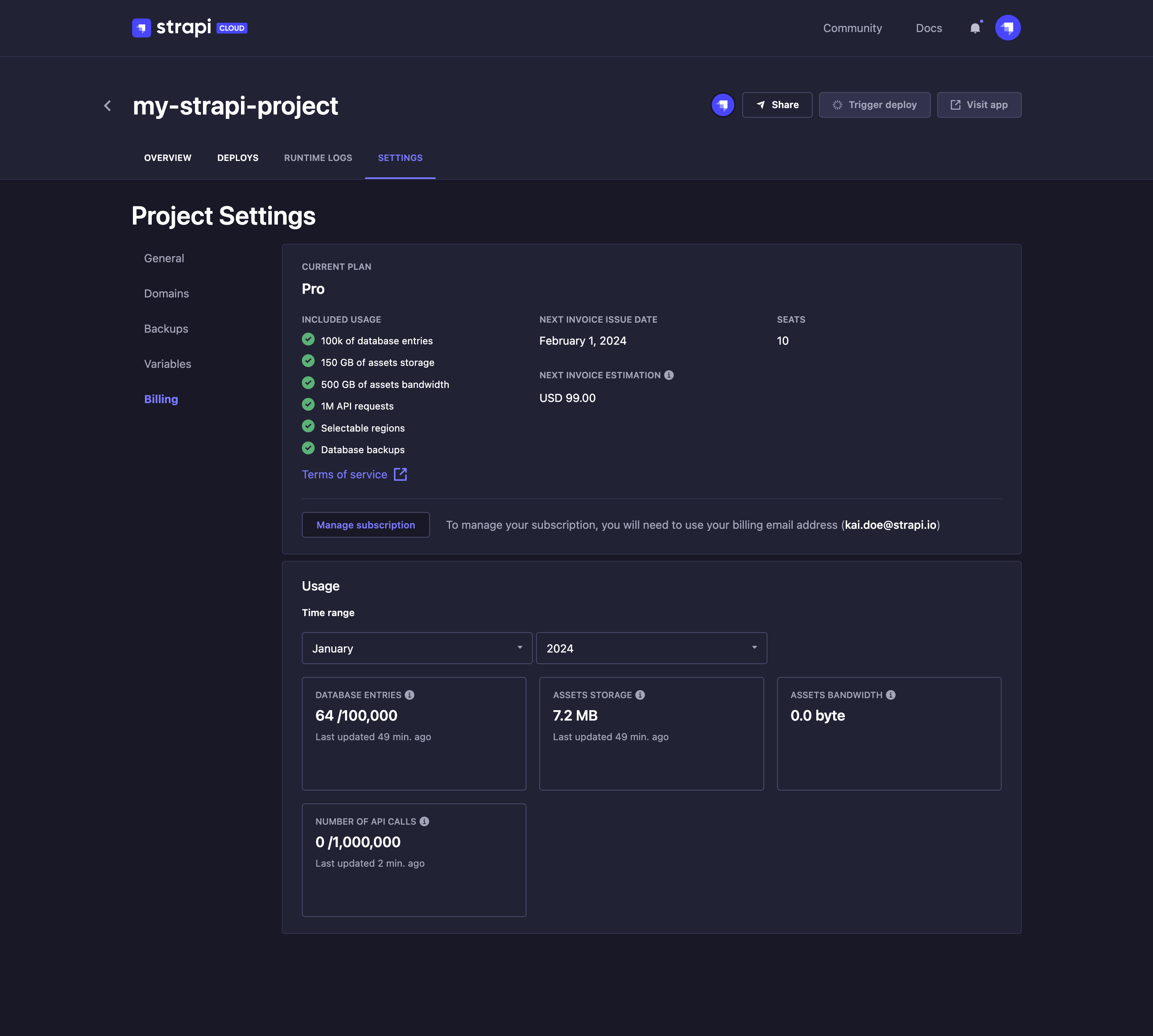
Plans
The Plans tab displays an overview of the available Strapi Cloud plans and allows you to change your current plan, or your billing cycle.
If your current plan is labeled as legacy, you will be able to sidegrade to a new plan (see downgrade section). Once you sidegrade, you will no longer have access to your previous plan.
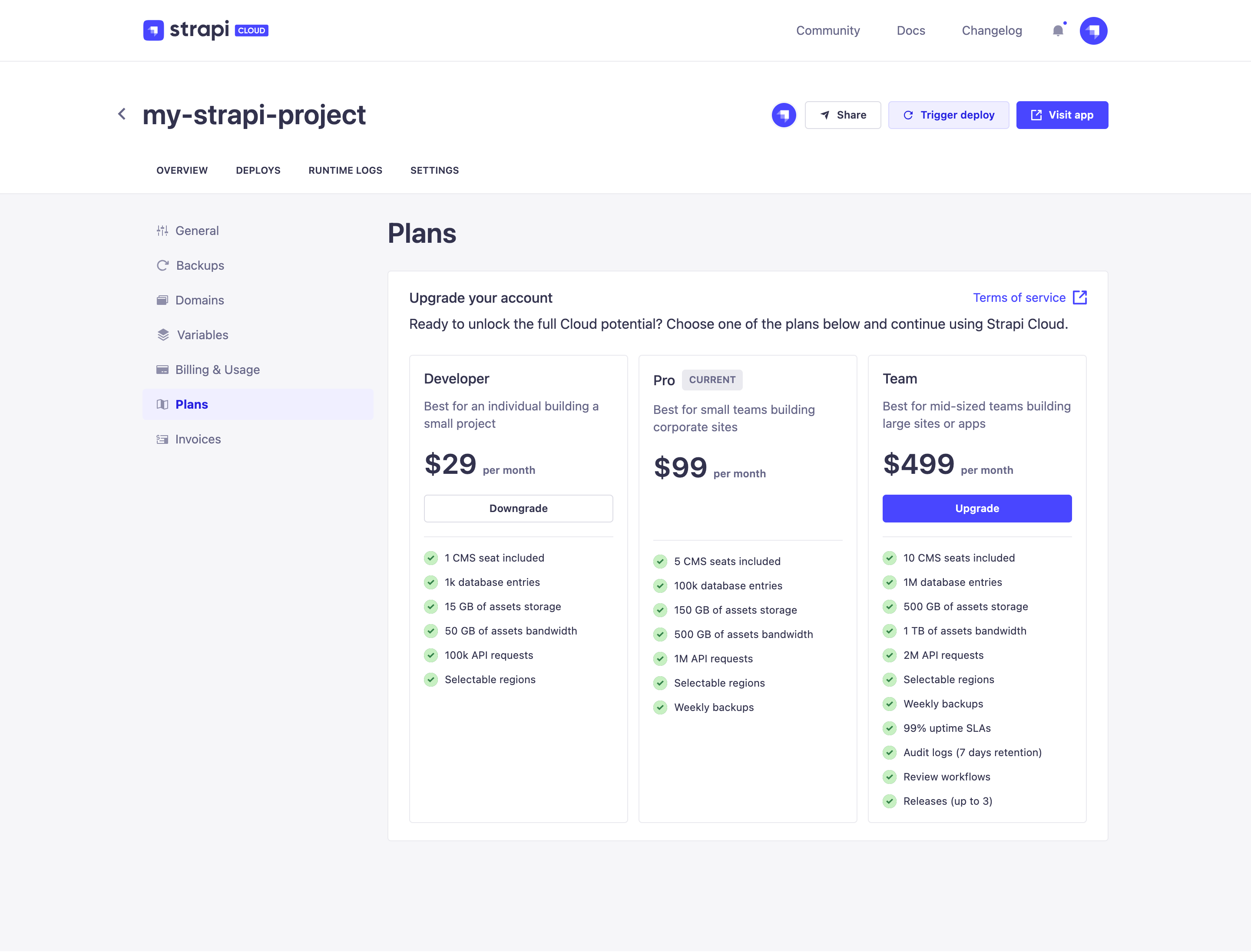
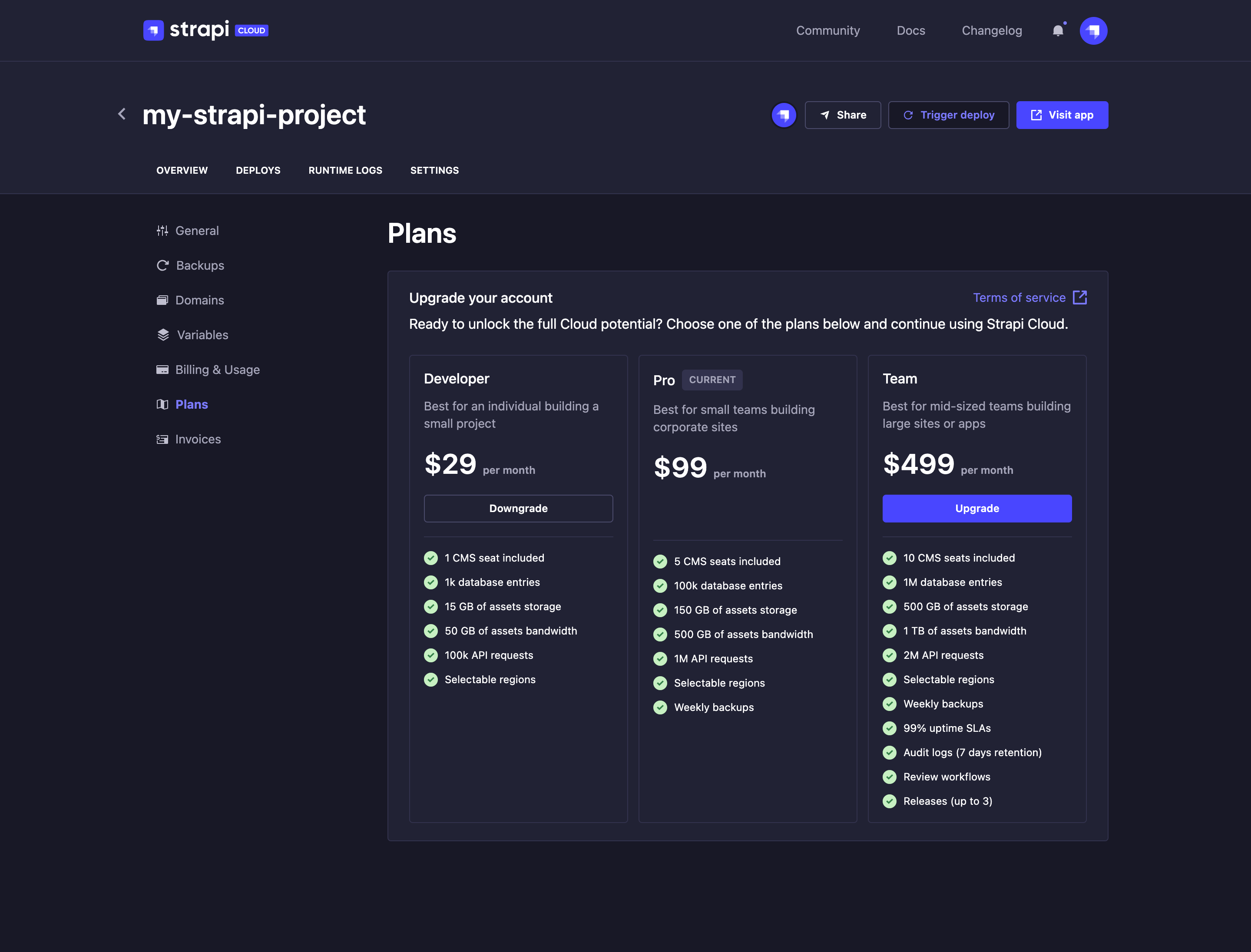
Upgrading to another plan
Plan upgrades are immediate and can be managed, for each project, via the project settings.
To upgrade your current plan to a higher one:
-
In the Plans tab of your project settings, choose between monthly and yearly billing frequency, and click on the Upgrade button of the plan you want to upgrade to.
-
In the window that opens, review the payment details and terms of the upgrade.
a. (optional) Click the Edit button to select another payment method.
b. (optional) Click I have a discount code, enter your discount code in the field, and click on the Apply button.
-
Click on the Upgrade to [plan name] button to confirm the upgrade. The project will automatically be re-deployed.
Downgrading to another plan
Plan downgrades can be managed, for each project, via the project settings. Downgrades are, however, not immediately effective: the current plan will remain active until the end of the current billing period.
Make sure to check the usage of your Strapi Cloud project before downgrading: if your current usage exceeds the limits of the lower plan, you are taking the risk of getting charged for overages. You may also lose access to some features: for example, downgrading to the Essential plan would result in the loss of all your project's backups. Please refer to Information on billing & usage for more information.
Note also that you cannot downgrade if you have additional paid environments. You will first need to delete all additional environments that were not included in the base price of you plan (see Resetting & Deleting environment) before you can schedule a downgrade. When downgrading from Pro to Scale, the additional included environment will automatically be deleted when the downgrade takes effect.
To downgrade your current plan to a lower one:
- In the Plans tab of your project settings, choose between monthly and yearly billing frequency and click on the Downgrade button of the plan you want to downgrade to.
- In the window that opens, review the terms of the downgrade.
- Click on the Downgrade button to confirm the downgrade. The project will automatically be re-deployed.
Downgrades are effective at the end of the current billing period. Whilst the change is pending, you can cancel the scheduled downgrade and stay on your current plan.
Changing billing cycle
You can switch your project's billing cycle between monthly and yearly billing at any time. While project plans and addons can either be billed monthly or yearly depending on your billing cycle, overages are always billed monthly.
To change your billing cycle:
- In the Plans tab of your project settings, use the toggle at the top of the plans section to switch between monthly and yearly billing.
- Click the Switch to [monthly/yearly] billing button of your current plan.
- In the window that opens, review the terms of the billing cycle change.
- Click Confirm switch to confirm the change.
When switching from yearly to monthly billing, your plan will remain on its yearly cycle until your next renewal date. Whilst the change is pending, you can cancel the scheduled change and stay on your current billing cycle. When switching from monthly to yearly, however, the change is immediate.
Invoices
The Invoices tab displays the full list of invoices for your Strapi Cloud project as well as their status. No invoice is issued for the Free plan.
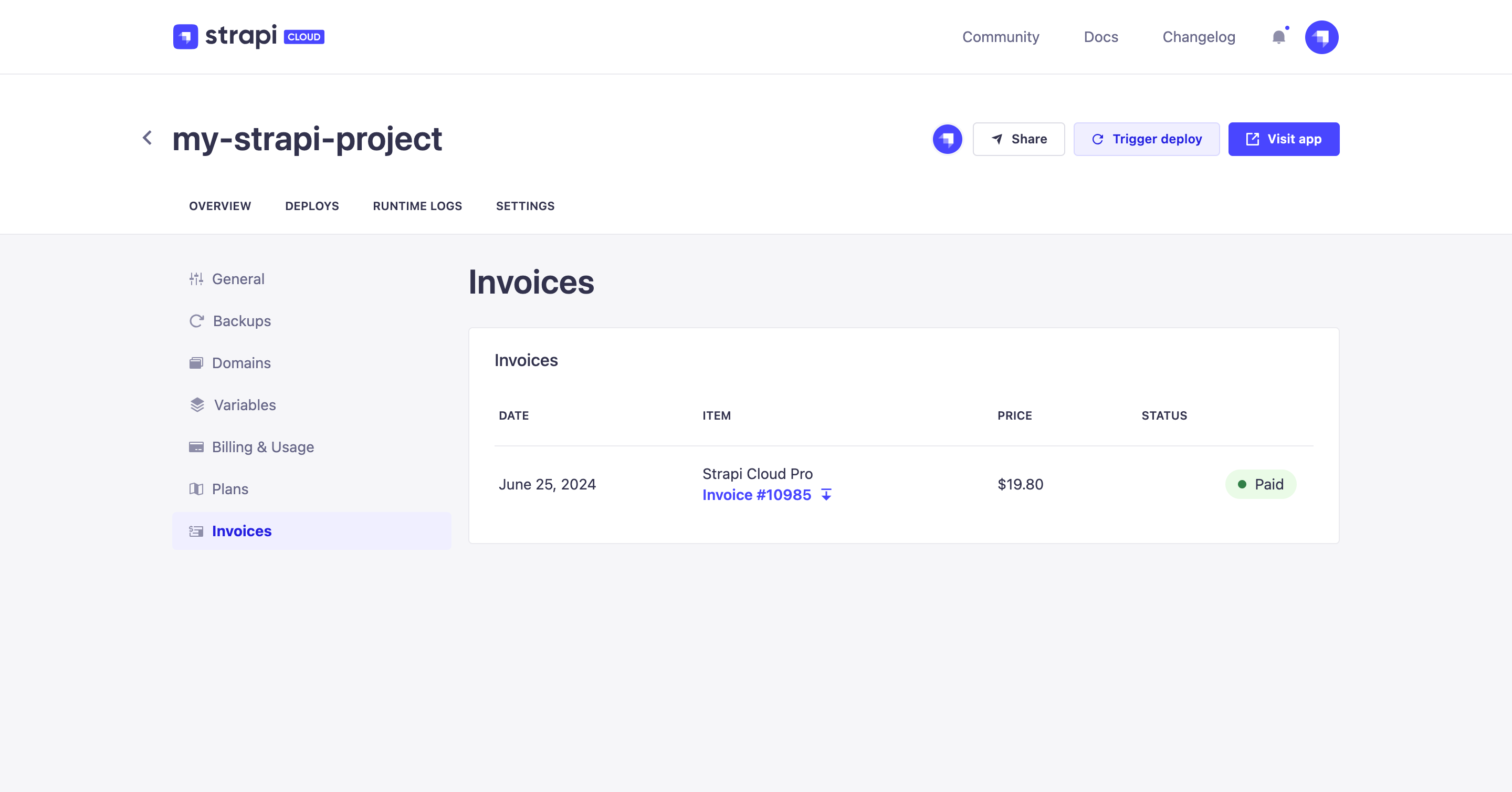
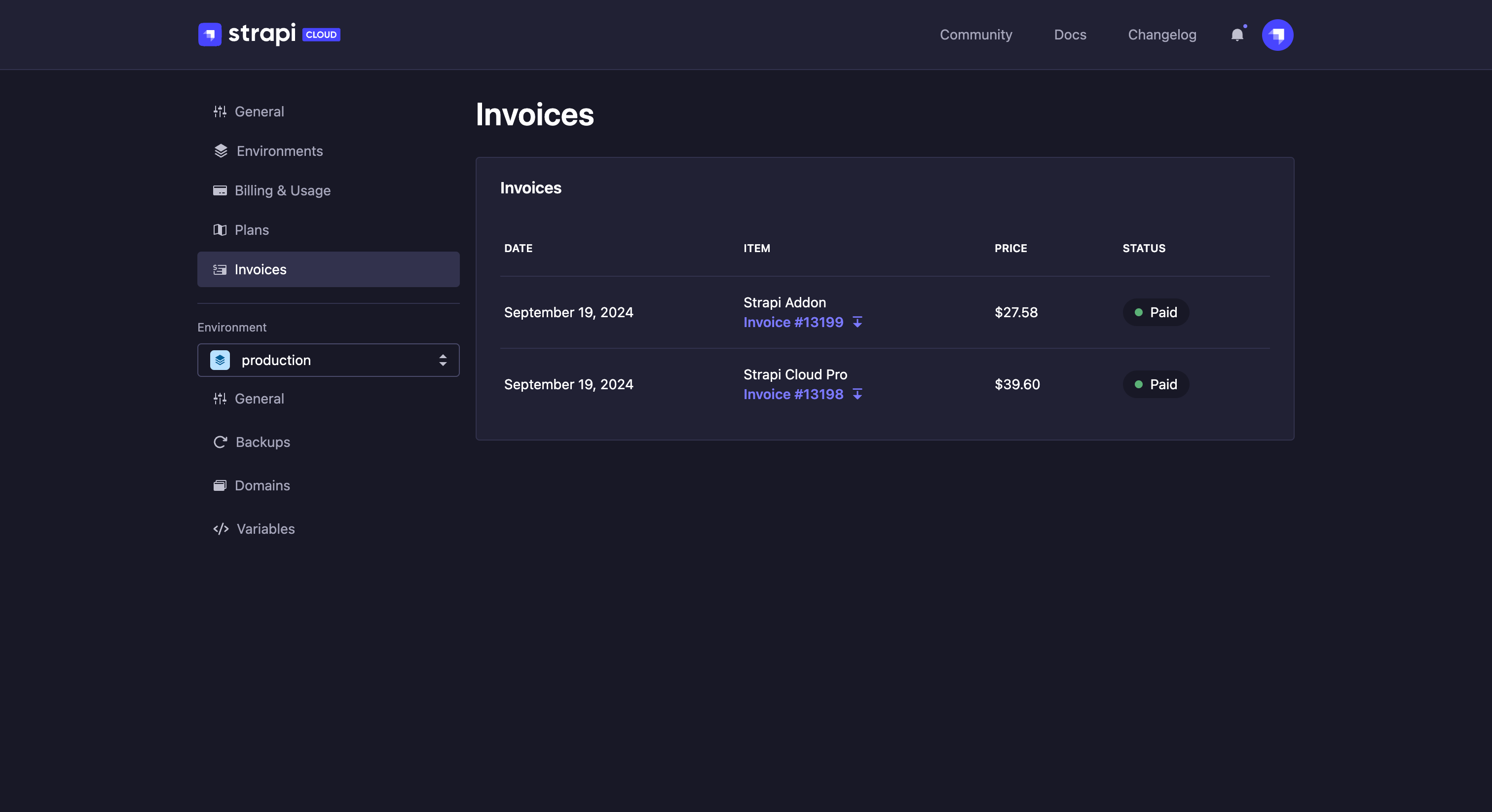
Invoices can have any of the following statuses:
- Paid: the payment has been done and the invoice is available, no additional action is required.
- Payment pending: the invoice is not complete or validated yet
- Payment due: the payment didn't go through and needs to be fixed
- Not paid: the payment has failed and won't automatically be retried
- Voided: the invoice has been cancelled.
Click the icon to download an invoice.
In the Profile > Invoices tab, you will find the complete list of invoices for all your projects. Feel free to check the dedicated documentation.
Environment-level settings
In the project's environments' settings, you first need to select the environment whose settings you would like to configure, using the dropdown. Depending on the chosen environment, there are 3 to 4 tabs available:
- Configuration,
- Backups, which are only available for the production environment,
- Domains,
- and Variables.
Configuration
The Configuration tab for the environment-level settings enables you to check and update the following options for the project:
- Basic information, to see:
- the name of your Strapi Cloud project's environment. The environment name is set when it is created and cannot be modified afterwards.
- the Node version of the environment: to change the Node version of the project (see Modifying Node version).
- the app's internal name for the environment, which can be useful for debug & support purposes.
- Connected branch: to change the branch of the GitHub repository used for your environment (see Editing Git branch). Also allows to enable/disable the "deploy on push" option.
- Environment data: to transfer data from another environment within the same project (see Transferring data between environments).
- Danger zone: to reset or permanently delete your Strapi Cloud project's environment (see Resetting & Deleting environment).
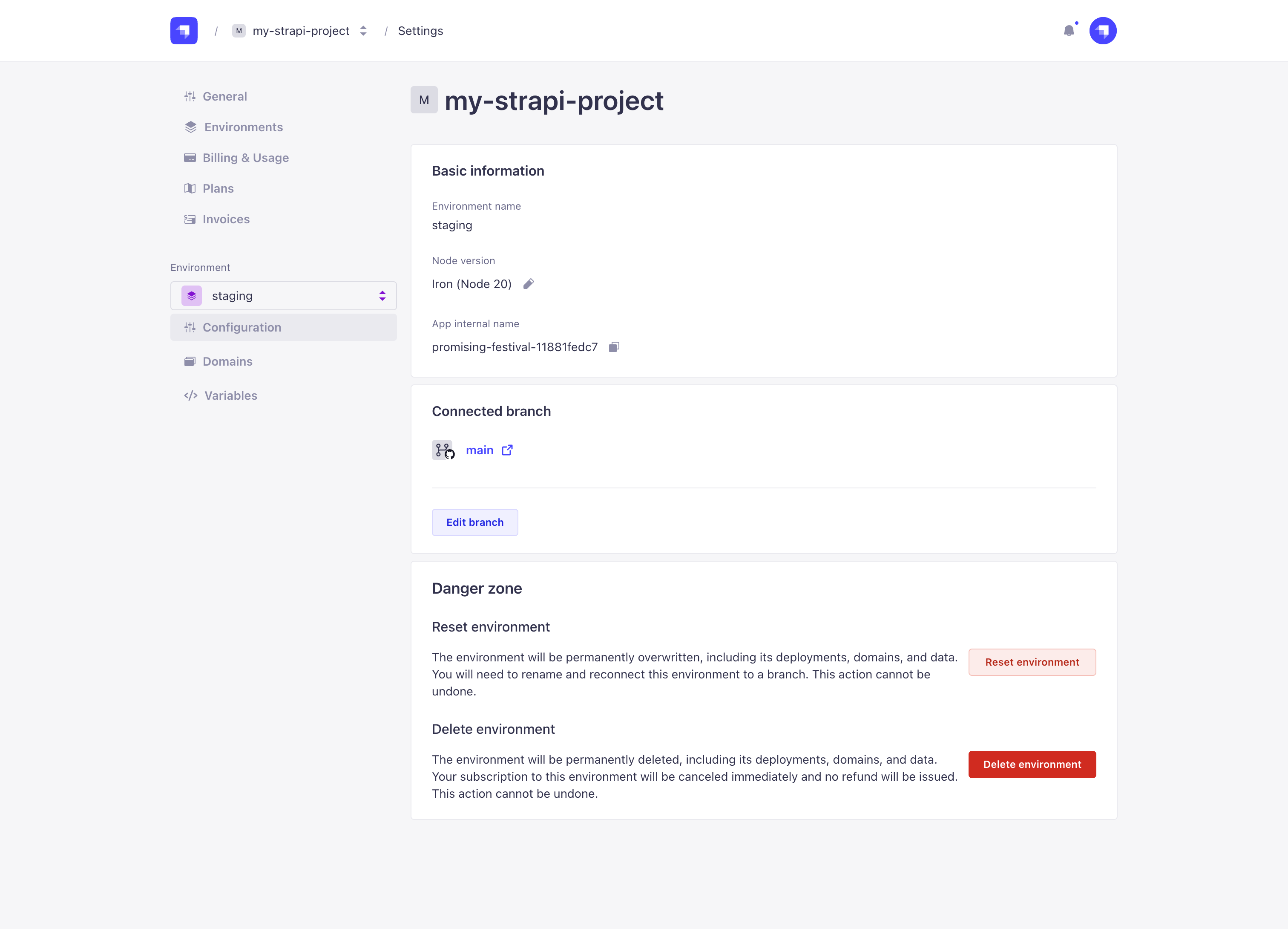
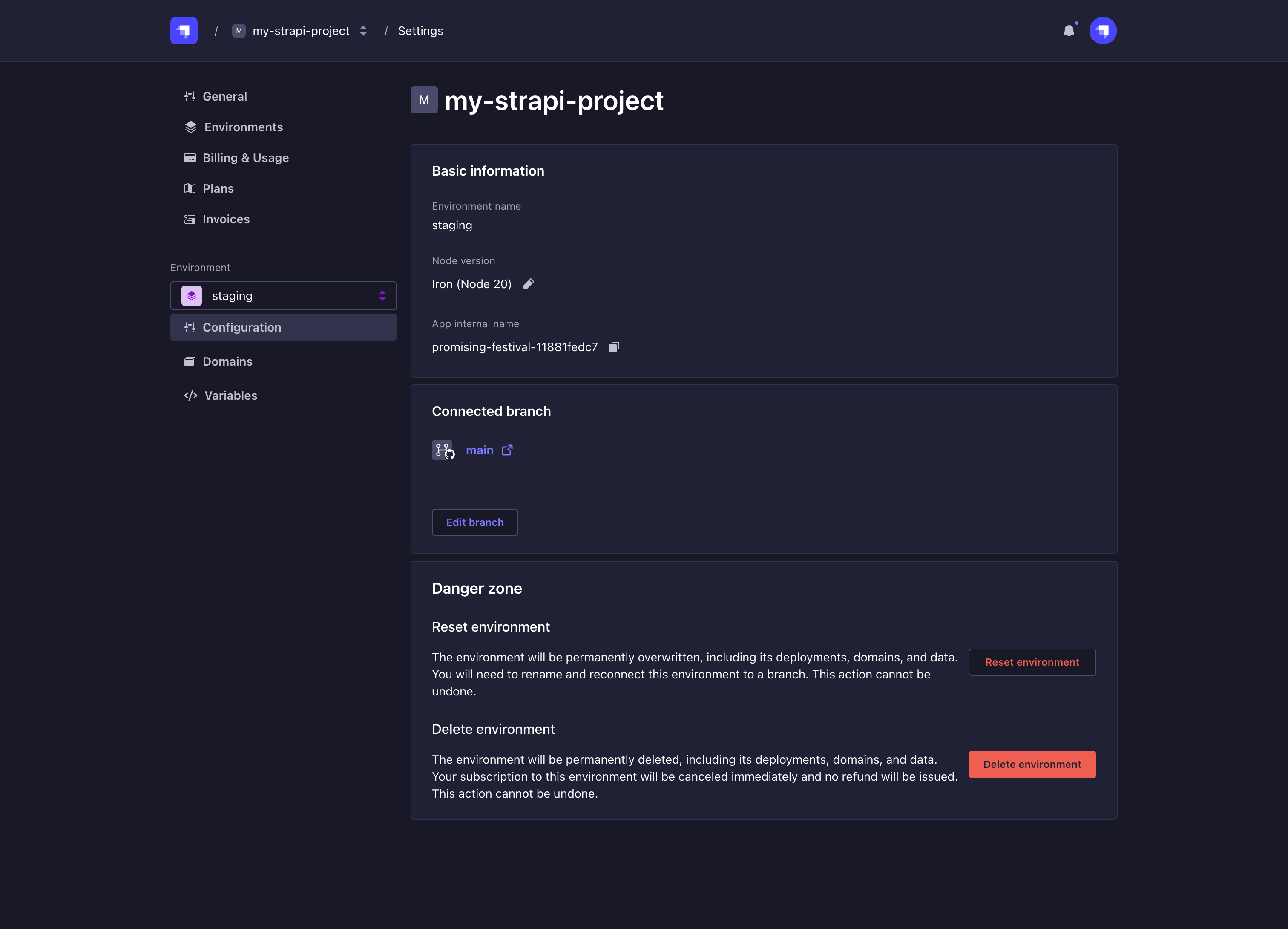
Modifying Node version
The environment's Node version is based on the one chosen at the creation of the project (see Creating a project), through the advanced settings. It is possible to switch to another Node version afterwards, for any environment.
- In the Basic information section of the Configuration tab, click on the Node version's edit button.
- Using the Node version drop-down in the dialog, click on the version of your choice.
- Click on Save, or Save & deploy if you want the changes to take effect immediately.
Ensure the Node version configured in your Strapi project matches the Node version shown in your project’s dashboard before deploying.
Editing Git branch
-
In the Edit branch dialog, edit the available settings. Note that the branch can be edited for all environments at the same time via the project settings, see General.
Setting name Instructions Selected branch (mandatory) Choose a branch from the drop-down list. Base directory Write the path of the base directory in the textbox. Deploy the project on every commit pushed to this branch Tick the box to automatically trigger a new deployment whenever a new commit is pushed to the selected branch. Untick it to disable the option. -
Click on the Save & deploy button for the changes to take effect.
Transferring data between environments
ProThis feature is available with a Strapi Cloud Pro plan. ScaleThis feature is available with a Strapi Cloud Scale plan.The data transfer feature allows you to transfer the entire CMS content (database and assets) from one environment to another within the same Strapi Cloud project. This is useful for testing changes in a secondary environment with up-to-date production data, or for preparing and staging content in a secondary environment before taking it to production.
Transferring data between environments currently comes with the following limitations:
- You can only transfer toward a secondary environment (not the production environment).
- Only project owners can initiate and manage ongoing transfers.
- Transfers cannot be initiated on projects that are suspended.
Transferring data to an environment will permanently overwrite all existing data and assets in the target environment. The source environment's data remains unaffected, and its CMS can be accessed during the transfer. Environment settings (such as variables and domains) are not affected by the transfer.
To transfer data to a secondary environment:
- Create and deploy both the source and target environments.
- In the Environment data section of the Configuration tab, click on the Import data button.
- In the modal that opens, select the source environment from the dropdown list. Only fully created and deployed environments are available as sources.
- Click on Import data to proceed, and follow the steps to confirm the transfer.
- Once initiated, you will be redirected to the environment's dashboard where you can monitor the transfer's progress. Once the transfer is completed, the dashboard will refresh, showing both the ongoing and historic deployments.
The CMS of the target environment will be inaccessible whilst the transfer is ongoing. You can cancel an ongoing transfer, but this will leave the target environment empty. If an error occurs during the transfer, you will have the option to retry or cancel.
Resetting & Deleting environment
You can reset or delete any additional environment of your Strapi Cloud project, but it will be permanent and irreversible. The default, production environment, can however not be neither reset nor deleted.
Resetting an environment
Resetting an environment deletes all environments data and resets the variables to their default. To do so:
-
In the Danger zone section of the Configuration tab, click on the Reset environment button.
-
In the dialog that opens, click on the Continue button to confirm the environment reset.
-
Fill in the available fields to reset the environment:
Setting name Instructions Environment name (mandatory) Write a name for your project's new environment. Git branch (mandatory) Choose a branch from the drop-down list. Base directory Write the path of the base directory in the textbox. Import variables Tick the box to import variable names from an existing environment. Values will not be imported, and all variables will remain blank. Auto-deploy Deploy the project on every commit pushed to this branch -
Click on the Reset button.
Deleting an environment
- In the Danger zone section of the Configuration tab, click on the Delete environment button.
- Write in the textbox your Environment name.
- Click on the Delete environment button to confirm the deletion.
Backups
ProThis feature is available with a Strapi Cloud Pro plan. ScaleThis feature is available with a Strapi Cloud Scale plan.The Backups tab informs you of the status and date of the latest backup of your Strapi Cloud projects. The databases associated with all existing Strapi Cloud projects are indeed automatically backed up (weekly for Pro plans and daily for Scale plans). Backups are retained for a 28-day period. Additionally, you can create a single manual backup.
-
The backup feature is not available for Strapi Cloud projects on the Free or Essential plans. You will need to upgrade to the Pro or Scale plan to enable automatic backups and access the manual backup option.
-
Backups include only the database of your default Production environment. Assets uploaded to your project and databases from any secondary environments are not included.
-
The manual backup option becomes available shortly after the project’s first successful deployment.
For projects created before the release of the Backup feature in October 2023, the first backup will automatically be triggered with the next deployment of the project.
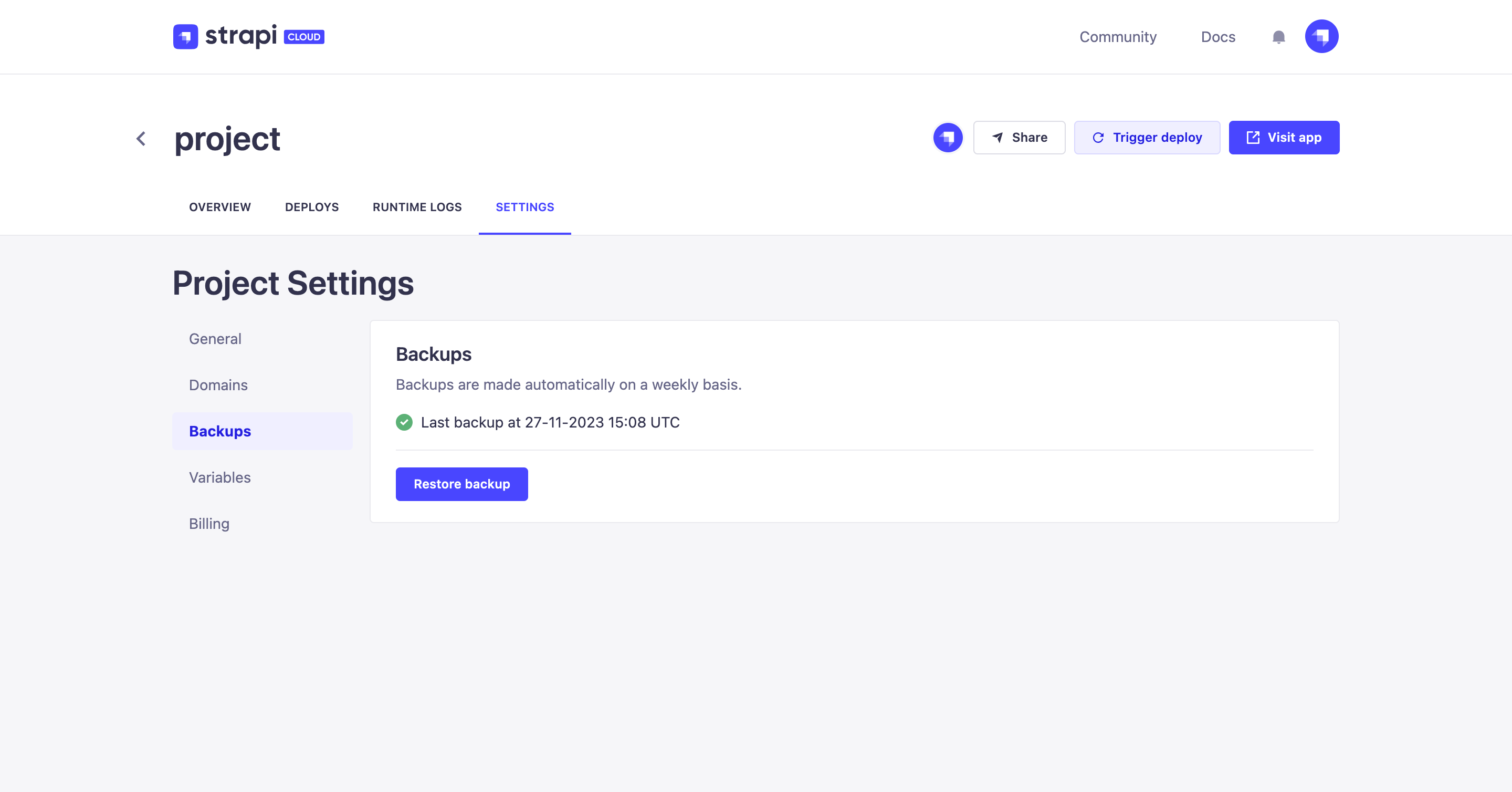
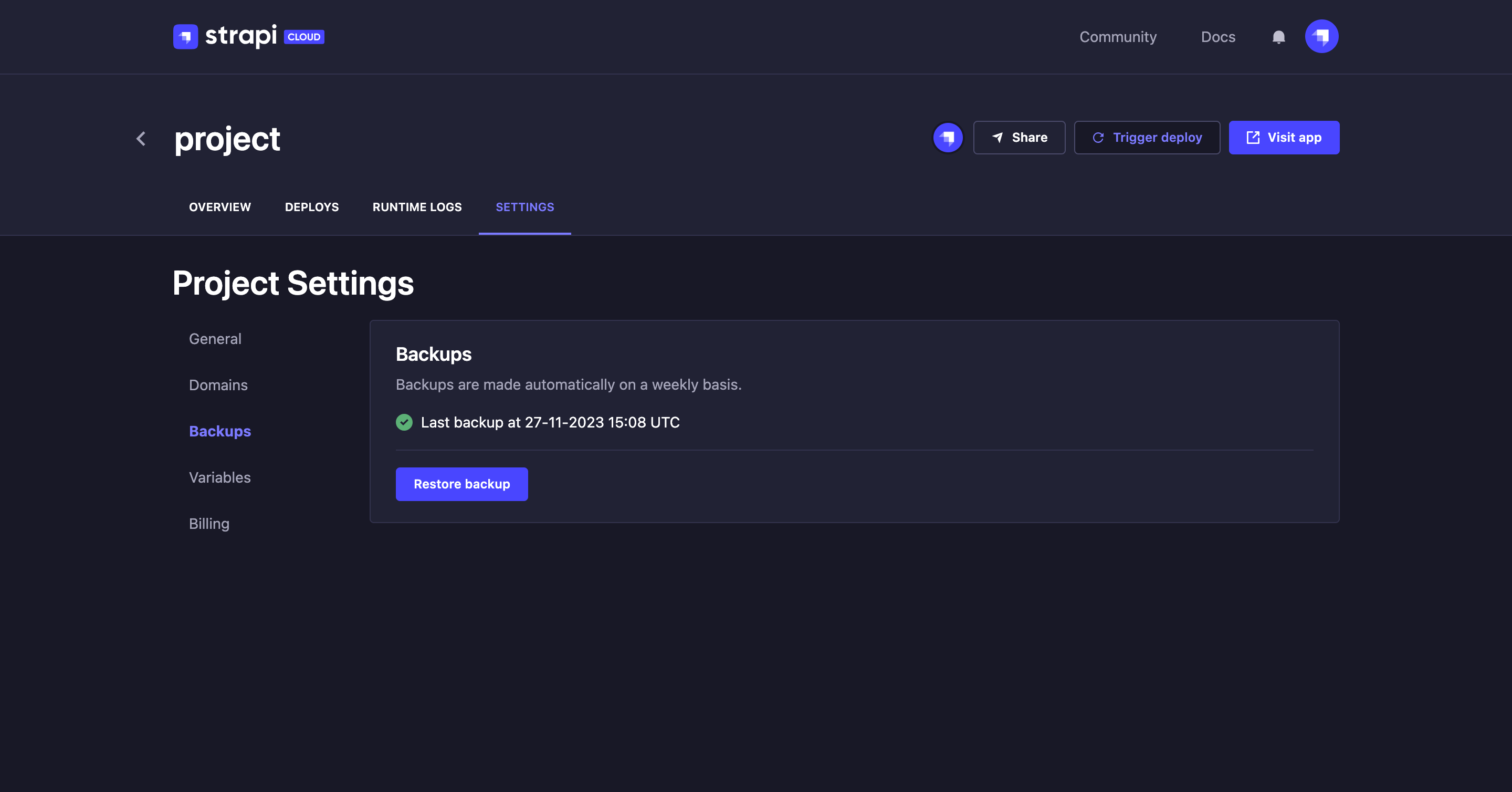
Creating a manual backup
To create a manual backup, in the Backups section, click on the Create backup button.
The manual backup should start immediately, and restoration or creation of other backups will be disabled until the backup is complete.
When creating a new manual backup, any existing manual backup will be deleted. You can only have one manual backup at a time.
Restoring a backup
If you need to restore a backup of your project:
- In the Backups section, click on the Restore backup button.
- In the dialog, choose one of the available backups (automatic or manual) of your project in the Choose backup drop-down.
- Click on the Restore button of the dialog. Once the restoration is finished, your project will be back to the state it was at the time of the chosen backup. You will be able to see the restoration timestamp and the backup restored in the Backups tab.
- The timestamp of the last completed restoration will be displayed to help you track when the project was last restored.
Downloading a backup
If you need to download a backup of your project:
- In the Backups section, click on the Download backup button.
- In the dialog, choose one of the available backups (automatic or manual) of your project in the Choose backup drop-down.
- Click on the Download button of the dialog to download the chosen backup's archive file in
.sqlformat.
The backup file will include only the database of your default Production environment. It will not include assets or any other environment databases.
Domains
The Domains tab enables you to manage domains and connect new ones.
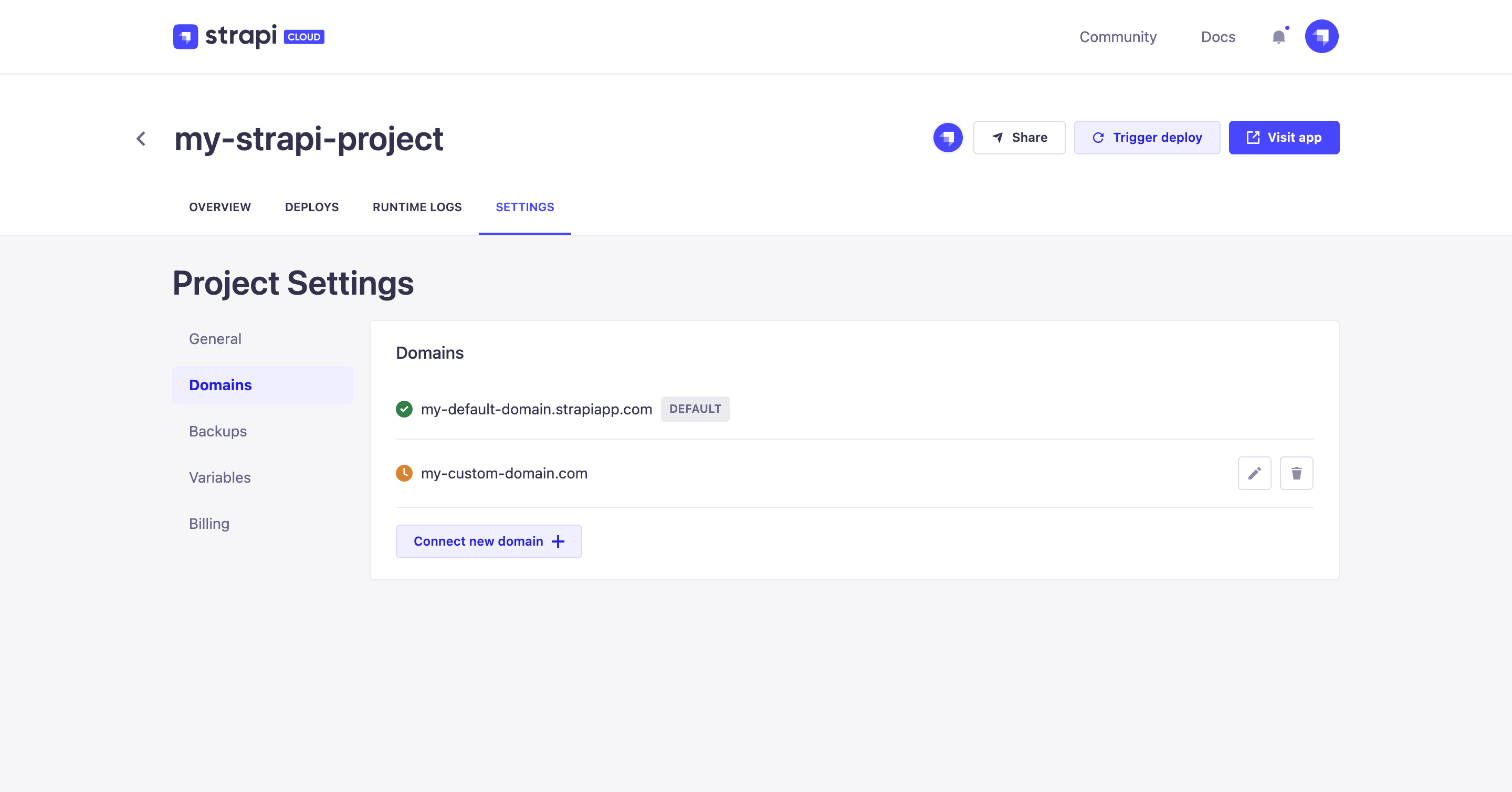
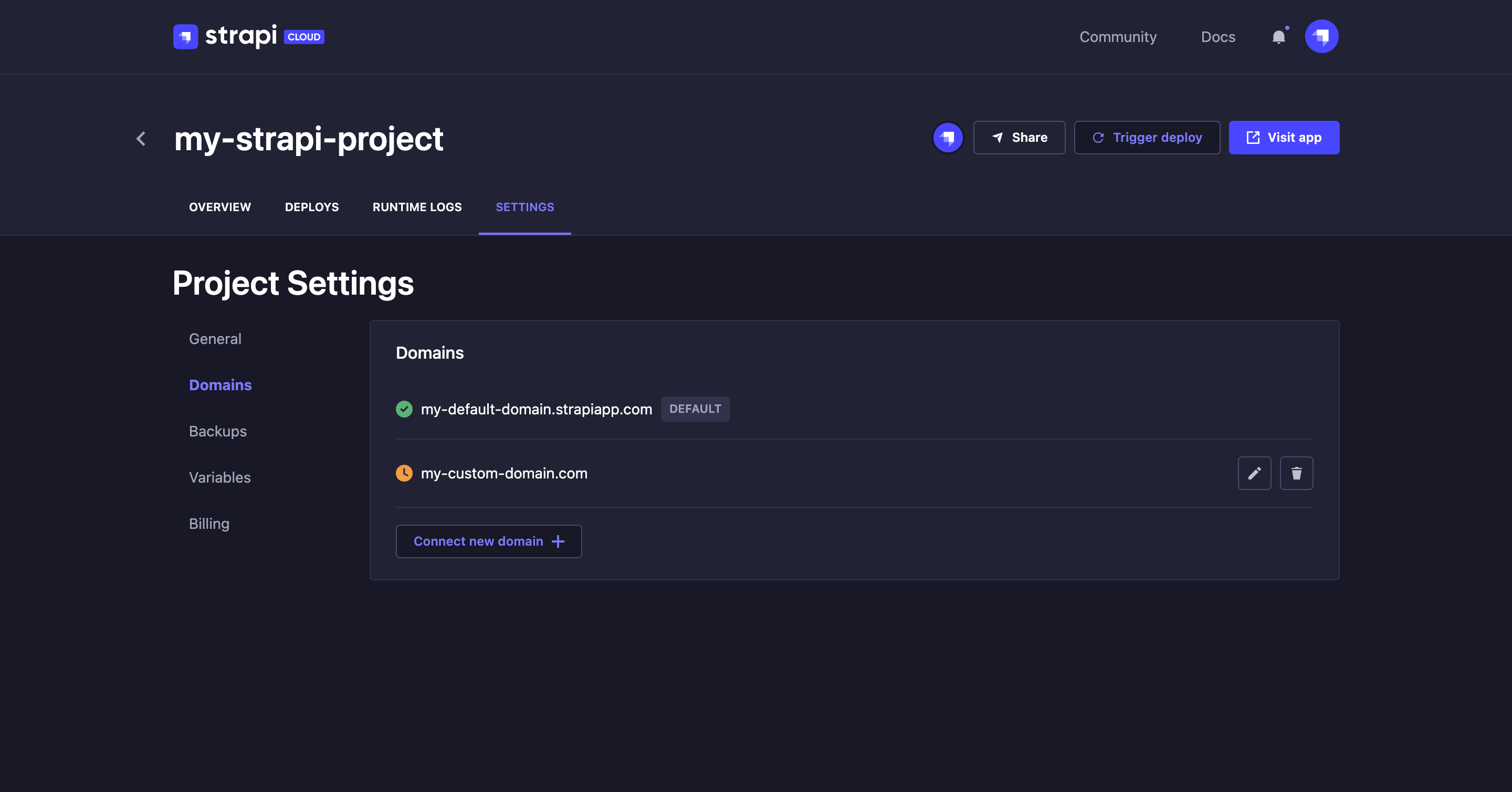
All existing domains for your Strapi Cloud project are listed in the Domains tab. For each domain, you can:
- see its current status:
- Active: the domain is currently confirmed and active
- Pending: the domain transfer is being processed, waiting for DNS changes to propagate
- Failed: the domain change request did not complete as an error occured
- click the edit button to access the settings of the domain
- click the delete button to delete the domain
Connecting a custom domain
Default domain names are made of 2 randomly generated words followed by a hash. They can be replaced by any custom domain of your choice.
Custom domains are not available on the Free plan. Downgrading to the Free plan will result in the application domain's being restored to the default one.
- Click the Connect new domain button.
- In the window that opens, fill in the following fields:
| Setting name | Instructions |
|---|---|
| Domain name | Type the new domain name (e.g. custom-domain-name.com) |
| Hostname | Type the hostname (i.e. address end-users enter in web browser, or call through APIs). |
| Target | Type the target (i.e. actual address where users are redirected when entering hostname). |
| Set as default domain | Tick the box to make the new domain the default one. |
- Click on Save & deploy for the changes to take effect.
To finish setting up your custom domain, in the settings of your domain registar or hosting platform, please add the Target value (e.g., proud-unicorn-123456af.strapiapp.com) as a CNAME alias to the DNS records of your domain.
When using custom domains, these domains do not apply to the URLs of uploaded assets. Uploaded assets keep the Strapi Cloud project-based URL.
This means that, if your custom domain is hosted at https://my-custom-domain.com and your Strapi Cloud project name is my-strapi-cloud-instance, API calls will still return URLs such as https://my-strapi-cloud-instance.media.strapiapp.com/example.png.
Media library queries over REST or GraphQL always return the project media domain on Strapi Cloud. If you move from a self-hosted project, where media URLs can match your own domain or CDN, plan to keep using the absolute URLs from the API or adjust your frontend to allow the Strapi Cloud media domain (see Cloud Fundamentals for more details).
Variables
Environment variables (more information in the CMS Documentation) are used to configure the environment of your Strapi application, such as the database connection.
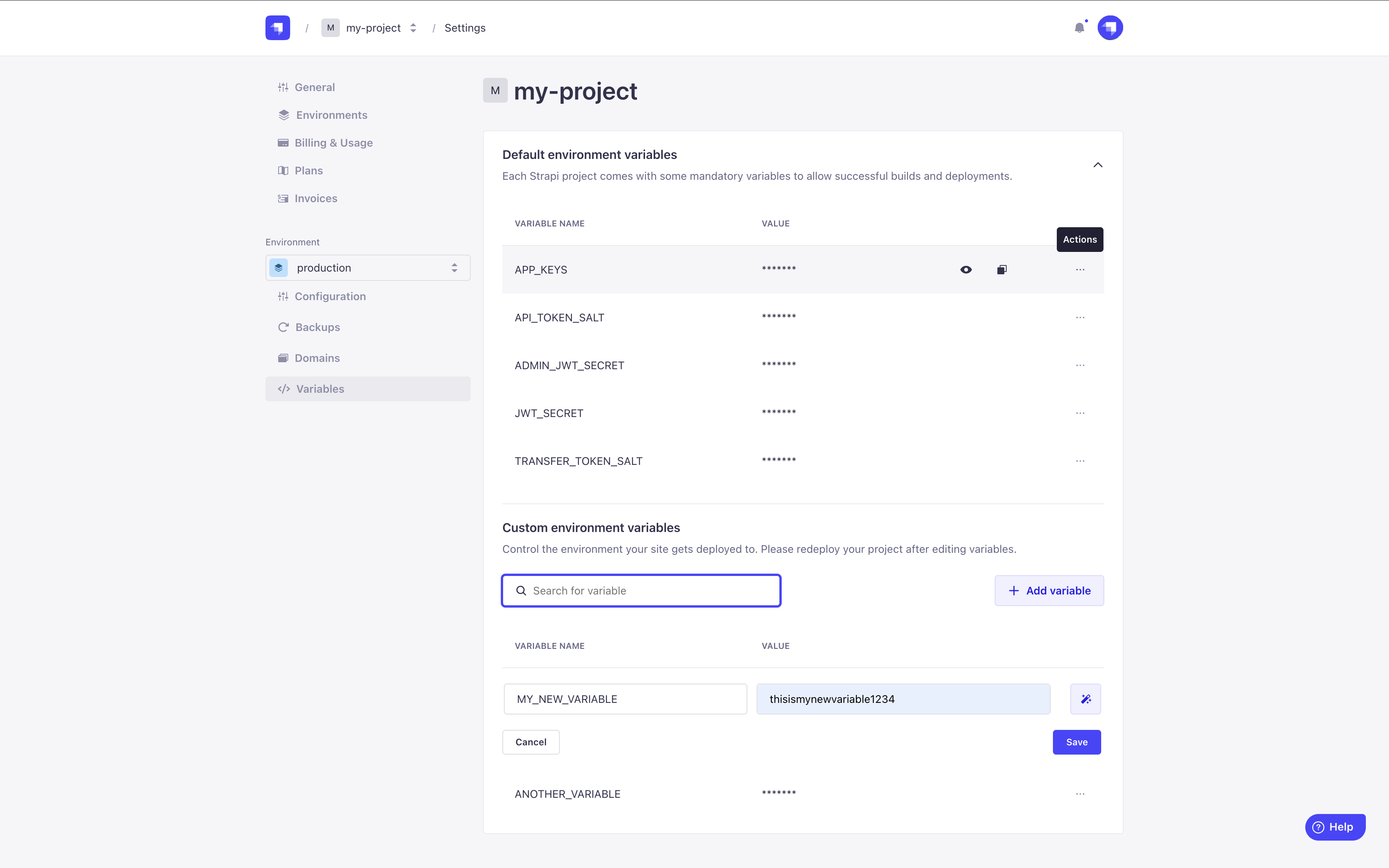
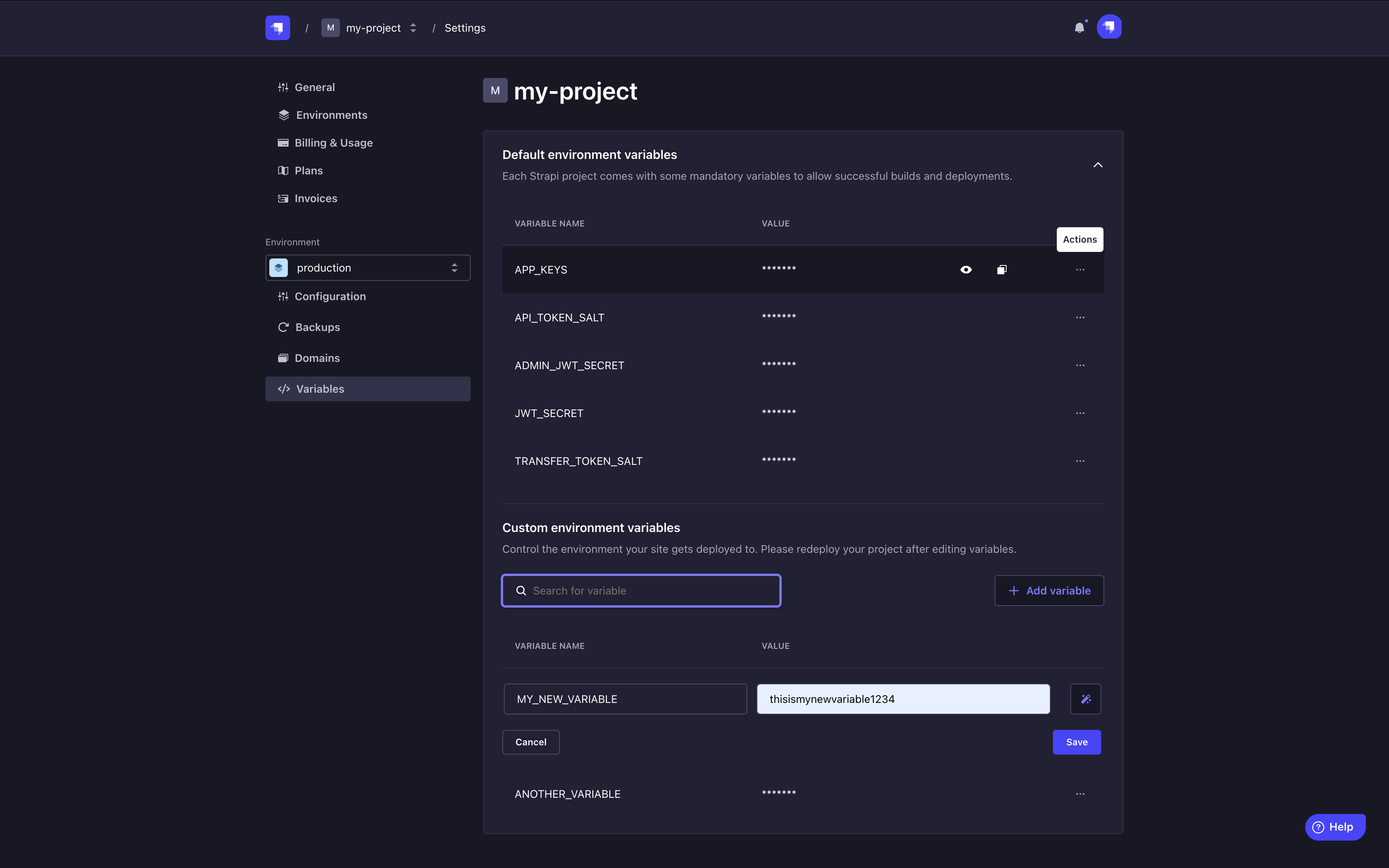
In the Variables tab are listed both the default and custom environment variables for your Strapi Cloud project. Each variable is composed of a Name and a Value.
Managing environment variables
Hovering on an environment variable, either default or custom, displays the following available options:
- Show value to replace the
*characters with the actual value of a variable. - Copy to clipboard to copy the value of a variable.
- Actions to access the Edit and Delete buttons.
- When editing a default variable, the Name cannot be modified and the Value can only be automatically generated using the Generate value button. Don't forget to Save, or Save & deploy if you want the changes to take effect immediately.
- When editing a custom variable, both the Name and Value can be modified by writing something new or by using the Generate value button. Don't forget to Save, or Save & deploy if you want the changes to take effect immediately.
- When deleting a variable, you will be asked to confirm by selecting Save, or Save & deploy if you want the changes to take effect immediately.
Use the search bar to find more quickly an environment variable in the list!
Creating custom environment variables
Custom environment variables can be created for the Strapi Cloud project. Make sure to redeploy your project after creating or editing an environment variable.
- In the Custom environment variables section, click on the Add variable button.
- Write the Name and Value of the new environment variable in the same-named fields. Alternatively, you can click on the icon to generate automatically the name and value.
- (optional) Click on Add another to directly create one or more other custom environment variables.
- Click on the Save button to confirm the creation of the custom environment variables. To apply your changes immediately, click on Save & deploy.